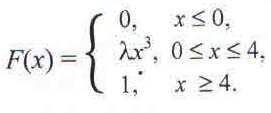1. Use the trapezium rule with 4 sub- intervals to estimate

correct to three decimal places.
2. A body of mass 4kg is moving with an initial velocity of 5ms-1 on a plane. The kinetic energy of the body is reduced by 16 Joules in a distance of 40m. Find the deceleration of the body.
3. A continuous random variable X has a cumulative distribution function:

Find the
a) value of the constant λ.
b) probability density function , f(x).
4. The table below shows the values of f(x) for given values of x.
|
x |
0.4 |
0.6 |
0.8 |
|
f(x) |
-0.9613 |
-0.5108 |
-0.2231 |
Use linear interpolation to determine f-1(-0.4308) correct to 2 decimal places.
5. A particle of mass 2kg rests in limiting equilibrium on a rough plane inclined at 300 to the horizontal. Find the value of the coefficient of friction.
6. A bag contains 5 Pepsi Cola and 4 Miranda bottle tops. Three bottle tops are picked at random from the bag one after the other without replacement. Find the probability that the bottle tops picked are of the same type.
7. The data below shows the length in centimeters of different calendars produced by a printing press. A cumulative frequency distribution was formed.
|
Length (cm) |
<20 |
<30 |
<35 |
<40 |
<50 |
<60 |
|
Cumulative frequency |
4 |
20 |
32 |
42 |
48 |
50 |
a) Construct a frequency distribution table.
b) Draw a histogram and use it to estimate the modal length.
c) Find the mean length of the calendars.
8. Five forces of magnitudes 3N, 4N, 4N, 3N and 5N act along the lines AB,BC, CD, DA and AC respectively, of a square ABCD of side 1m. The direction of the forces is given by the order of the letters. Taking AB and AD as reference axes; find the
a) magnitude and direction of the resultant force.
b) point where the line of action of the resultant force cuts the side AB.
9. A ball is projected vertically upwards and it returns to its point of projection 3 seconds later. Find the:
a) speed with which the ball was projected.
b) greatest height reached.
10. The table below shows the values of two variables P and Q.
|
P |
14 |
15 |
25 |
20 |
15 |
7 |
|
Q |
30 |
25 |
20 |
18 |
15 |
22 |
Calculate the rank correlation coefficient between the two variables.
11. Given the equation x3 -6x2 + 9x + 2 =0;
a) show that the equation has a root between -1 and 0
b) i) show that the Newton Raphson formula for approximating the root of the equation is given by

ii) use the formula in b(i) above, with an initial approximation of x0= -0.5, to find the root of the given equation correct to two decimal places.
12. A newspaper vendor buys 12 copies of a sports magazine every week. The probability distribution for the number of copies sold in a week is given in the table below.
|
Number of copies sold |
9 |
10 |
11 |
12 |
|
Probability |
0.2 |
0.35 |
0.30 |
0.15 |
a) Estimate the
i) expected number of copies that she sells in a week.
ii) variance of the number of copies sold in a week.
b) The vendor buys the magazine at Shs 1,200 and sells it at Shs 1,500. Any copies not sold are destroyed. Construct a probability distribution table for the vendor’s weekly profit from the sales. Hence calculate her mean weekly profit.
13. A particle starts from rest at a point (2,0,0) and moves such that its acceleration at any time t>0 is given by
a= [16cos 4t i + 8sin 2tj + (sin t -2sin 2t) k]ms-2
Find the:
a) speed when 
b) distance from the origin when 
14.The numbers x and yare approximated by X and Y with errors ∆x and ∆yrespectively.
a) Show that the maximum relative error in xy is given by

b) If x = 4.95 and y = 2.013 are each rounded off to the given number of decimal places, calculate the
i) percentage error in xy,
ii) limits within which xy is expected to lie. Give your answer to three decimal places.
15. The drying time of a newly manufactured paint is normally distributed with mean 110.5 minutes and standard deviation 12 minutes.
a) Find the probability that the paint dries between 104 and 109 minutes.
b) If a random sample of 20tins of paint was taken, find the probailtu that the mean drying time of the sample is between 108 and 112 minutes.
16. A particle of mass 2 kg moving with Simple Harmonic Motion (SHM) along the x-axis, is attracted towards the origin O by a force of 32x Newtons. Initially the particle is at rest at x= 20. Find the
a) amplitude an period of the oscillation.
b) velocity of the particle at any time, t >0
c) speed when  s.
s.
END
